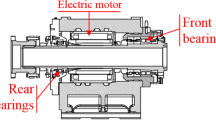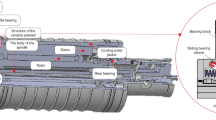Abstract
The model based on the velocity and acceleration of temperature variation (MBOTV) was established for spindle thermal growth error. However, the thermophysical parameters of MBOTV, such as the thermal expansion coefficient related to the velocity of temperature variation, Hv, the thermal expansion coefficient related to the acceleration of temperature variation, Ha, and the thermal inertia coefficient of the spindle, τ, may change during actual working. In order to analyze the influence of thermophysical parameters on the prediction accuracy of MBOTV, it is necessary to calculate the reliability of MBOTV. Actually, it is difficult to obtain the function of MBOTV. Although the improved response surface method can be used to calculate the reliability of the model with implicit function, the accuracy is not enough obviously when the implicit function is replaced by linear polynomials. Therefore, an improved response surface method based on quadratic polynomial approximation was proposed in this paper to calculate the reliability of MBOTV. In this method, the linear polynomial was replaced by a quadratic polynomial without cross product terms to replace the implicit function, which can improve the accuracy of reliability calculation. The predicted residual errors of MBOTV with single-parameter fluctuation and multi-parameter fluctuation were given in this paper. Studies reveal that MBOTV has strong robustness when the thermophysical parameters change.













Similar content being viewed by others
References
Liu K, Li T, Liu H, Liu Y, Wang Y (2020) Analysis and Prediction for Spindle Thermal Bending Deformations of a Vertical Milling Machine. IEEE T Ind Inform 16(3):1549–1558. https://doi.org/10.1109/TII.2019.2926991
Liu K, Liu Y, Sun M, Wu Y, Zhu T (2017) Comprehensive thermal growth compensation method of spindle and servo axis error on a vertical drilling center. Int J Adv Manuf Technol 88(9-12):2507–2516. https://doi.org/10.1007/s00170-016-8972-y
Liu K, Sun M, Zhu T, Wu Y, Liu Y (2016) Modeling and compensation for spindle’s radial thermal drift error on a vertical machining center. Int J Mach Tool Manu 105:58–67. https://doi.org/10.1016/j.ijmachtools.2016.03.006
Liu K, Chen F, Zhu T, Wu Y, Sun M (2016). Compensation for spindle’s axial thermal growth based on temperature variation on vertical machine tools. Adv Mech Eng, 8(16878140166577338). doi: https://doi.org/10.1177/1687814016657733
Shi X, Yang X, Mu Y, Wang Y, Wang W (2019) Thermal error compensation model for a motorized spindle with shaft core cooling based on exponential function. Int J Adv Manuf Technol 103(9-12):4805–4813. https://doi.org/10.1007/s00170-019-04038-w
Yao X, Hu T, Yin G, Cheng C (2020) Thermal error modeling and prediction analysis based on OM algorithm for machine tool’s spindle. Int J Adv Manuf Technol 106(7-8):3345–3356. https://doi.org/10.1007/s00170-019-04767-y
Li Y, Wei W, Su D, Zhao W, Zhang J, Wu W (2018) Thermal error modeling of spindle based on the principal component analysis considering temperature-changing process. Int J Adv Manuf Technol 99(5-8):1341–1349. https://doi.org/10.1007/s00170-018-2482-z
Li Y, Zhao J, Ji S (2018) Thermal positioning error modeling of machine tools using a bat algorithm-based back propagation neural network. Int J Adv Manuf Technol 97(5-8):2575–2586. https://doi.org/10.1007/s00170-018-1978-x
Liu Y, Miao E, Liu H, Chen Y (2020) Robust machine tool thermal error compensation modelling based on temperature-sensitive interval segmentation modelling technology. Int J Adv Manuf Technol 106(1-2):655–669. https://doi.org/10.1007/s00170-019-04482-8
Huang S, Feng P, Xu C, Ma Y, Ye J, Zhou K (2018) Utilization of heat quantity to model thermal errors of machine tool spindle. Int J Adv Manuf Technol 97(5-8):1733–1743. https://doi.org/10.1007/s00170-018-2051-5
Yang J, Fan K (2013) Research on the Thermal Deformation Pseudo-lag and Real-time Compensation for CNC Machine Tool Spindle. Journal of Mechanical Engineering 49(23):129–135. https://doi.org/10.3901/JME.2013.23.129
Creighton E, Honegger A, Tulsian A, Mukhopadhyay D (2010) Analysis of thermal errors in a high-speed micro-milling spindle. Int J Mach Tool Manu 50(4SI):386–393. https://doi.org/10.1016/j.ijmachtools.2009.11.002
Huang X, Hu S, Zhang Y (2017) On the Calculation Method for the Reliability of Chatter Stability in CNC Milling. Journal of Northeastern University. Nat Sci 38(5):675–679. https://doi.org/10.3969/j.issn.1005-3026.2017.05.014
Liu Y, Meng L, Liu K, Zhang Y (2016) Chatter reliability of milling system based on first-order second-moment method. Int J Adv Manuf Technol 87(1-4):801–809. https://doi.org/10.1007/s00170-016-8523-6
Wu J, Zhou J (2015) Reliability-based topology optimization of implicit performance function structure. China Mechanical Engineering 26(16):2203–2208. https://doi.org/10.3969/j.issn.1004-132X.2015.16.013
Huang Z, Yang T, Li F (2018). A decoupling algorithm with first-order asymptotic integration for reliability-based design optimization. Adv Mech Eng, 10(16878140187933369). doi: https://doi.org/10.1177/1687814018793336
Jiang C, Liu L, Tang Y (2012) A Structural Reliability Analysis Method for Hybrid Model with Interval Variables. Automot Eng:727–732
Eshghi AT, Lee S (2019) Adaptive improved response surface method for reliability-based design optimization. Eng Optim 51(12):2011–2029. https://doi.org/10.1080/0305215X.2018.1561885
Lee S (2019) Reliability based design optimization using response surface augmented moment method. J Mech Sci Technol 33(4):1751–1759. https://doi.org/10.1007/s12206-019-0327-9
Zhang D, Han X, Jiang C, Liu J, Li Q (2017) Time-Dependent Reliability Analysis Through Response Surface Method. J Mech Design 139(0414044). https://doi.org/10.1115/1.4035860
Zhang J, Guo S, Tang C, Mo Y, Zhang Y, Zhang S (2017). An improved weighted response surface method based on vector projection sampling. Chinese Science Bulletin, 1854-1860
Allaix DL, Carbone VI (2011) An improvement of the response surface method. Struct Saf 33(2):165–172. https://doi.org/10.1016/j.strusafe.2011.02.001
Kim SH, Na SW (1997) Response surface method using vector projected sampling points. Struct Saf 19(1):3–19. https://doi.org/10.1016/S0167-4730(96)00037-9
Acknowledgements
The authors thank the anonymous referees and editor for their valuable comments and suggestions.
Availability of data and material
All data generated or analyzed during this study are included in this published article.
Funding
This research was supported by the National Natural Science Foundation of China (51775085, U1608251), Liaoning Revitalization Talents Program (XLYC1807081), Liaoning Science and Technology Major Project (2020JH1/10100016), Youth Science and Technology Star of Dalian (2018RQ14), Top and Leading Talents of Dalian (2018RD05), Open project of State Key Lab of Digital Manufacturing Equipment & Technology (DMETKF2019014), National Key R&D Program of China (2019YFB2005400), and Changjiang Scholar Program of the Chinese Ministry of Education (T2017030).
Author information
Authors and Affiliations
Contributions
Kuo Liu and Haibo Liu contributed the central idea and analyzed most of the data. Yongqing Wang contributed to refining the ideas. Lei Song performed the research and wrote the initial draft of the paper. Wei Han and Mingjia Sun carrying out additional analyses and finalizing this paper.
Corresponding author
Ethics declarations
Ethical approval
This study complies with the ethical standards set out by Springer.
Consent to participate
Not applicable.
Consent to publish
Not applicable.
Competing interests
The authors declare no competing interests.
Additional information
Publisher’s note
Springer Nature remains neutral with regard to jurisdictional claims in published maps and institutional affiliations.
Rights and permissions
About this article
Cite this article
Liu, K., Song, L., Liu, H. et al. The influence of thermophysical parameters on the prediction accuracy of the spindle thermal error model. Int J Adv Manuf Technol 115, 617–626 (2021). https://doi.org/10.1007/s00170-021-07256-3
Received:
Accepted:
Published:
Issue Date:
DOI: https://doi.org/10.1007/s00170-021-07256-3




